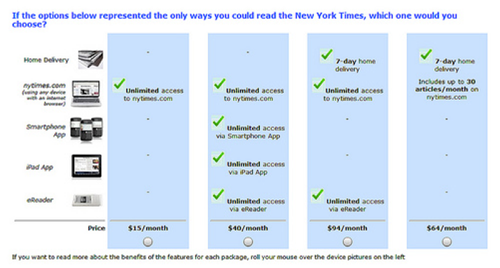Sign up for the daily CJR newsletter.
Ever since The New York Times announced in January that it would install a paywall by early 2011, speculation about how it will work has been high. All the detail the Times provided at the time was that it would allow site visitors to freely access a certain number of articles per month before hitting a paywall, and that print subscribers would be allowed unlimited access to the site without any additional charge. Articles accessed via search engines would not count toward the monthly total, which seemed an interesting loophole.
But how much would a new online-only subscription cost? And how many articles would be free before the gate slammed shut?
The strategy session must still be going on, as Peter Kafka writes over at All Things Digital. An online survey that targeted some subscribers last week shows that the Times is still trying to figure out how much they can charge for subscriptions before it becomes a deterrent to readers. (Which then becomes a deterrent to online advertisers.)
Here’s a screenshot of one question (courtesy of David Churbuck via Kafka) that proposes several bundles of access through different media, including smartphones, iPads, and e-readers:

Churbuck writes that the survey was very detailed; it took him about fifteen minutes to fill it out. I wonder if it would have been faster, though, if the questions were a little clearer. Here’s one of the questions:
Imagine again that the number of articles you can read for free on NYTimes.com is 20. How likely is it that you would subscribe to get unlimited access to NYTimes.com if you received a discount of 80% on the cost of $10 a month (regular subscription rate for users without a home delivery subscription)?
As Kafka points out, that seems to be a roundabout way of asking home delivery subscribers whether they would be willing to pay two dollars a month for unlimited online access on top of their regular subscription. That’s assuming that, under that scheme, non-print subscribers could subscribe to the online version alone for ten dollars a month. (That would also contradict the Times’ previous statement in January that print subscribers would not have to pay extra for online access, so we should read that one as a hypothetical.)
I don’t currently subscribe to the Times, so I didn’t get a chance to take the survey. But I do agree with Kafka that these types of questions “show us that paper is thinking hard about giving home delivery subscribers — who are incredibly valuable — a reason to remain home delivery subscribers.”
Print subscribers are always going to be more valuable to advertisers than online visitors, even if online visitors pay to play. As Henry Blodget, CEO of Business Insider, wrote last month (emphasis his):
The print newspaper is such a good vehicle for delivering ads, in fact, that the New York Times generates about $55 per month of advertising revenue for every print subscriber it has ($650 million of annual print revenue divided by 1 million subscribers divided by 12 months). That’s in addition to the $58 per month the New York Times induces subscribers to pay for the daily print ad-delivery vehicle ($700 million of annual circulation revenue divided by 1 million subscribers divided by 12 months). The New York Times web site, in contrast, only generates about $0.70 of ad revenue per month from each of the 18 million people who visit it–and zero (ZERO) circulation revenue.
So it makes sense that the Times wants people to pay for the content they’re currently getting online for free, but it doesn’t want to encourage online-only subscriptions, either.
This is a balance that seems achievable. I’ll just take my own buying habits as an example. Right now, I buy the Sunday Times at the newsstand every week for six dollars, and get unlimited online access for free, giving me exactly what I want for twenty-four dollars a month. In my area, the cheapest subscription option is the Saturday-Sunday deal, which costs about twenty-five dollars per month after the introductory offer runs out. I’ve never bothered to sign up for that because the Saturday paper is only about four pages long anyway.
However, if I had to pay ten or fifteen dollars a month for online access, and if I were still paying the newsstand price for my beloved Sunday print edition, then my monthly Times bill would climb to thirty-five or thirty-nine dollars. I’d definitely have incentive to subscribe to home delivery if doing so gave me a steep discount for the Web.
Update, August 5: A PaidContent writer got his hands on a full copy of the Times reader survey; it can now be viewed and downloaded here.
Has America ever needed a media defender more than now? Help us by joining CJR today.






